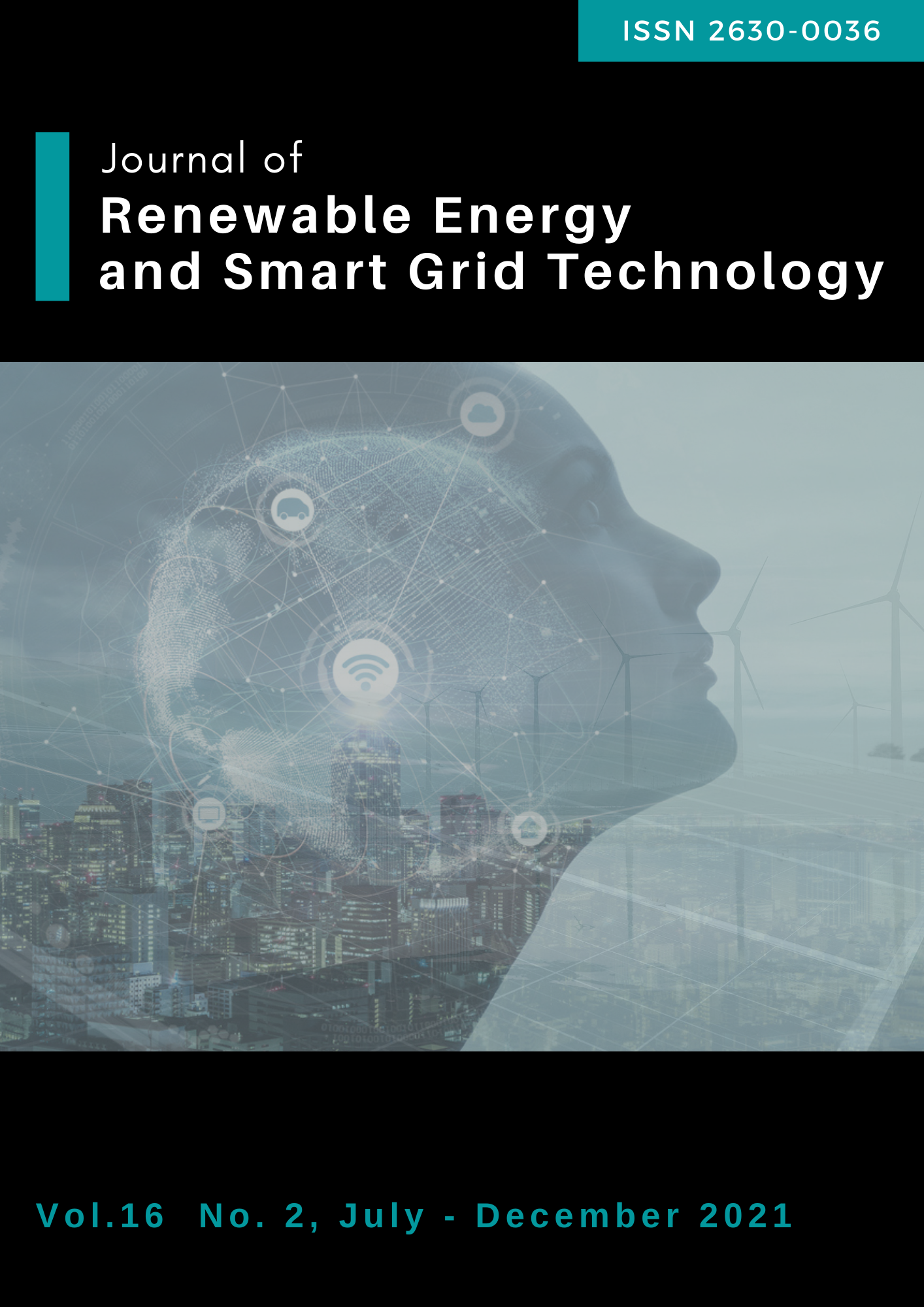The Production and Properties of Fuel Briquettes from Animal and Agricultural Bio-Waste to Renewable Energy Source in Rural Community
Keywords:
Fuel Briquettes, Agricultural Bio-Waste, Rural CommunitiesAbstract
Biomass energy is a basic energy requirement of rural communities in developing countries. Thailand is an agricultural country that has huge agricultural waste. Bio-waste is of interest, as animal waste (cow dung) and plant waste (rice straw and corncob) are easily found in many areas of Thailand. This research aimed to study the production and properties of bio-waste converted to fuel briquettes as an energy source for cooking fuel. The production results tested the suitable ratio of binders for fuel briquettes with the ratio between starch and water at 4:6 percent by weight. The ratio 2:1:7 cow dung:residue (rice straw, corn cob, rice straw+corn cob):binder with percent by weight was suitable for fuel briquettes which had good shape, smooth surface, strong shape and continuously flowed while extruding them from the fuel briquette machine. The property of fuel briquettes regarding the compressive strength was highest at 1.02±0.12 MPa of cow dung:corncob:binder. The heating value of cow dung:corncob+rice straw:binder was highest at 14.18 MJ/kg. The percentage ash content of cow dung:corncob+rice straw:binder was lowest at 12.95%, and the bulk density of cow dung:corncob+rice straw:binder was highest at 898.24 kg/m3. As a result, these fuel briquettes from bio-waste could be used as an alternative energy source for developing countries. There is potential for it to be a renewable energy source in many parts of Thailand.
References
Anozie, A. N., Odejobi, O. J., & Alozie, E. E. (2009). Estimation of carbon emission reduction in a cogeneration system using sawdust. Energy Sources, Part A: Recovery Utilization and Environmental effects, 31(9), 711-721.
Chin, O. C., & Siddiqui, K. M. (2000). Characteristics of some biomass briquettes prepared under modest die pressures. Biomass and Bioenergy, 18, 223-228.
Yaman, S., Sahansahan, M., Haykiri-Acma, H., Sesen, K., & Kuçukbayrak, S. (2001). Fuel Briquettes from Biomass-Lignite Blends. Fuel Processing Technology, 72(1), 1-8.
Jittabut, P. (2015). Physical and Thermal Properties of Briquette Fuels from Rice Straw and Sugarcane Leaves by Mixing Molasses. Energy Procedia, 79, 2-9.
Department of Alternative Energy Development and Efficiency (DEDE). (2012). Biomass Database Potential in Thailand, Ministry of Energy, Thailand, Retrieved July 11, 2020, from http://weben.dede.go.th/webmax/content/biomass-database-potential-thailand
Thai Industrial Standards Institute (TIST). (2004). Thai Community Products Standards of Charcoal Briquette. TCPS.238-2547. Bangkok: Thailand.
Prasityousil, J., & Muenjina, A. (2013). Properties of solid fuel briquettes produced from rejected material of municipal waste composting. Procedia Environmental Sciences, 17, 603-610.
Maduang, T., Chunhachart, O. & Pawongrat, R. (2018). The effect on morphological change of cellulose fibers by sonochemical-assisted pretreatment of lignocellusic biomass. Rajamangala University of Technology Suvarnabhumi Academic Journal, 6(1), 26-36.
Richard, S. R. (1990). Physical testing of fuel briquettes. Fuel Processing Technology, 25, 89-100.
Shuma, R., & Madyira, D. M. (2017). Production of loose biomass briquettes from agricultural and forestry residues. Procedia Manufacturing, 7, 98-105.
American Society for Testing of Material (ASTM). (1983). Annual book of ASTM standards, American Society for Testing of Material, Philadelphia, USA.
Hassan, L.G., Sani, N.A., Sokoto, A. M., & Tukur, U.G. (2017). Comparative Studies of Burning Rates and Water Boiling Time of Wood Charcoal and Briquettes Produced from Carbonized Martynia annua woody Shells. Nigerian Journal of Basic and Applied Sciences, 25(2), 21-27.
Davies, R. M., Davies, O. A., & Mohammed, U. S. (2013). Combustion Characteristics of Traditional Energy Sources and Water Hyacinth Briquettes. International Journal of Scientific Research in Environmental Sciences, 1(7), 144-151.
Sahu, P. K., Chakradhari, S., Dewangan, S., & Patel, K. S. (2016). Combustion Characteristics of Animal Manures. Journal of Environmental Protection, 7, 951-960.
Luchaichana, P., Loahalidanond, K., & Kerdsuwan, S. (2017). In-depth Study of Fuel Properties of Corn Residue (Cob, Stems/Leaves, and Husks) through the Torrefaction Process. Energy Procedia, 138, 662-667.
Kargbo, F. R., Xing, J., & Zhang, Y. (2010). Property analysis and pretreatment of rice straw for energy use in grain drying: A review. Agriculture and Biology Journal of North America, 1(3), 195-200.
Department of Alternative Energy Development and Efficiency (DEDE). (2015). Alternative Energy Development Plan: AEDP2012-2021, Ministry of Energy, Thailand, Retrieved July 11, 2020, from http://weben.dede.go.th/webmax/content/10-year-alternative-energy-development-plan
Panwar, V., Prasad, B., & Wasewar, K. L. (2011). Biomass Residue Briquetting and Characterization. Journal of Energy Engineering, 137(2), 108-114.
Szymajda, A., Laska, G., & Joka, M. (2021). Assessment of Cow Dung Pellets as a Renewable Solid Fuel in Direct Combustion Technologies. Journal of Energies, 14(4), 1192.
Kpalo, S., Zainuddin, M., Manaf, L., & Roslan, A. (2020). Production and Characterization of Hybrid Briquettes from Corncobs and Oil Palm Trunk Bark under a Low Pressure Densification Technique. Journal of Sustainabilitys, 12, 2468.
Rhofita, E., Hutardo, P., & Miraux, F. (2018). The Characterization of Rice Straw Briquette as an Alternative Fuel in Indonesia.. In Proceedings of the Built Environment, Science and Technology International Conference (BEST ICON 2018), 304-309.
Downloads
Published
How to Cite
Issue
Section
License
All copyrights of the above manuscript, including rights to publish in any media, are transferred to the SGtech.
The authors retain the following rights;
1. All proprietary rights other than copyright.
2. Re-use of all or part of the above manuscript in their work.
3. Reproduction of the above manuscript for author’s personal use or for company/institution use provided that
(a) prior permission of SGtech is obtained,
(b) the source and SGtech copyright notice are indicated, and
(c) the copies are not offered for sale.









